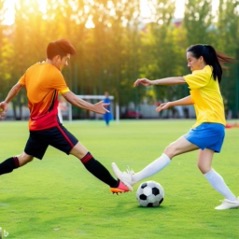Concussions are a concerning and prevalent issue in sports and various other activities that involve potential head injuries. While both males and females are susceptible to concussions, research shows that females have been traditionally under-represented in clinical studies. Several studies have shown there are differences in how concussions occur, their symptoms, and the recovery process between the genders. In this blog post, we will explore the disparities between male and female concussions, shedding light on the importance of gender-specific concussion management and recovery protocols.
1. Concussion Causes and Mechanisms: Male vs. Female
The causes and mechanisms of concussions can vary between males and females due to differences in physicality and participation in different sports. In contact sports such as football, rugby, and ice hockey, males are more likely to sustain concussions due to the nature of the sport and higher rates of physical contact. On the other hand, females might be more prone to concussions in soccer, where heading the ball and collisions can lead to head injuries.
In soccer and basketball, sports which are typically played by both males and females, females report higher rates of concussion that males. This may be in part due to differences in neck strength.
2. Symptoms and Reporting: Male vs. Female
Studies suggest that females tend to report more concussion symptoms. Females often express greater levels of emotional distress and are more likely to report symptoms such as headaches, dizziness, and sensitivity to light and noise.
On the contrary, females may not be taken as seriously by healthcare practitioners, especially when it comes to longer term symptoms.
3. Prevention and Education
Given the differences in concussion patterns between males and females, personalized concussion prevention strategies and education are essential. Coaches, medical professionals, and athletes should be aware of the gender-specific risks and symptoms associated with concussions. Proper coaching techniques, equipment use, and rule modifications in sports can help reduce the incidence of concussions for both males and females.
4. Addressing Gender Bias and Stereotypes
Addressing gender bias and stereotypes surrounding concussions is vital to ensure that all athletes receive equal care and attention regardless of their gender. Breaking down societal expectations that may discourage males from reporting symptoms or seeking help and challenging the notion that females are more “emotionally fragile” when it comes to head injuries is crucial in fostering a safe and supportive environment for concussion management.
Conclusion
While concussions affect both males and females, it is evident that gender differences exist in the causes, symptoms, and recovery processes associated with these injuries. Acknowledging these differences and developing gender-specific concussion management protocols can lead to more effective prevention, treatment, and recovery strategies. Proper education, awareness, and destigmatizing the reporting of symptoms are essential steps in promoting athlete well-being and ensuring a safer sports environment for everyone. Emphasizing the importance of personalized care and addressing the unique needs of male and female athletes can make a significant impact in managing concussions and protecting the long-term health of all participants.
